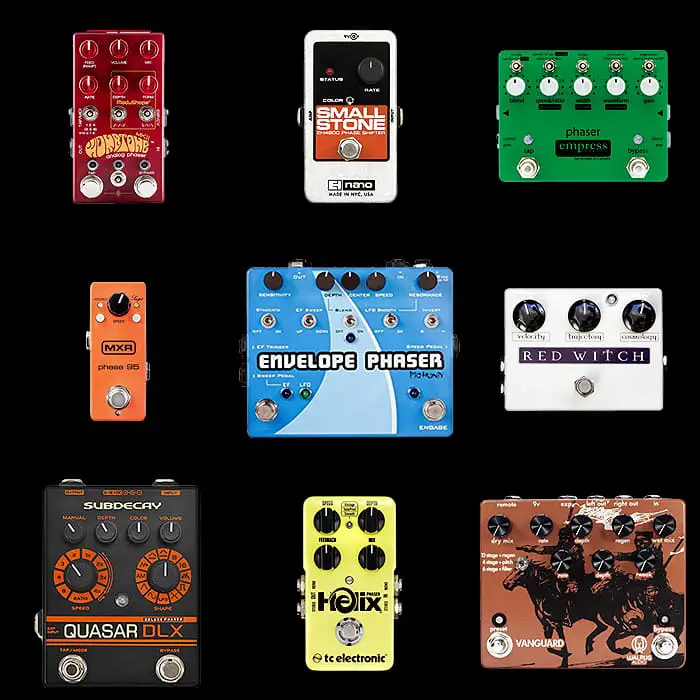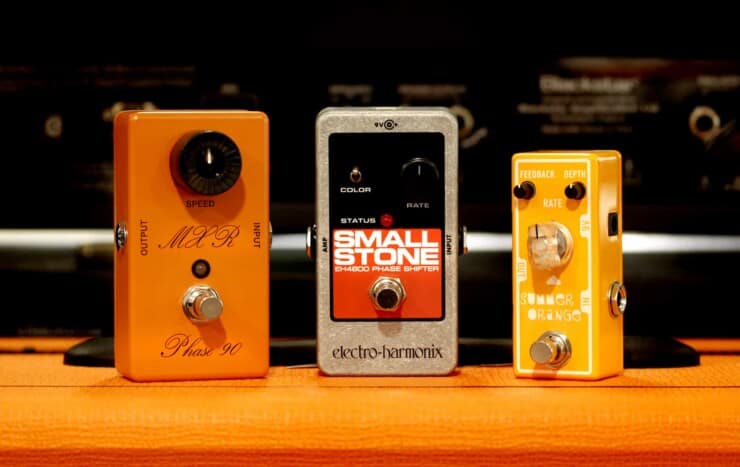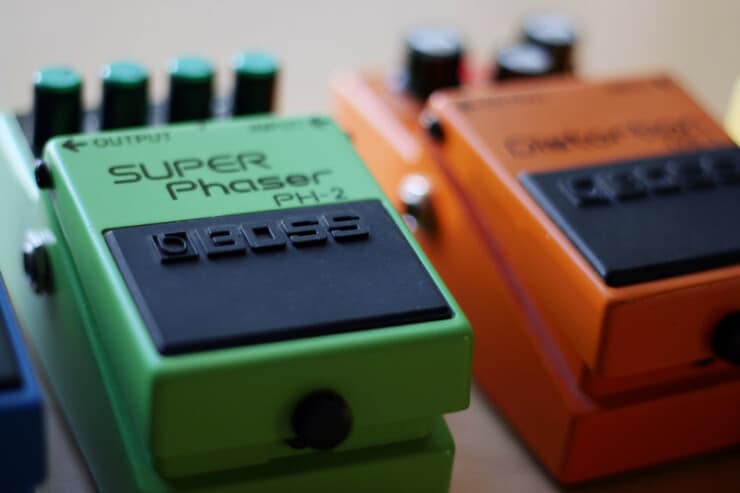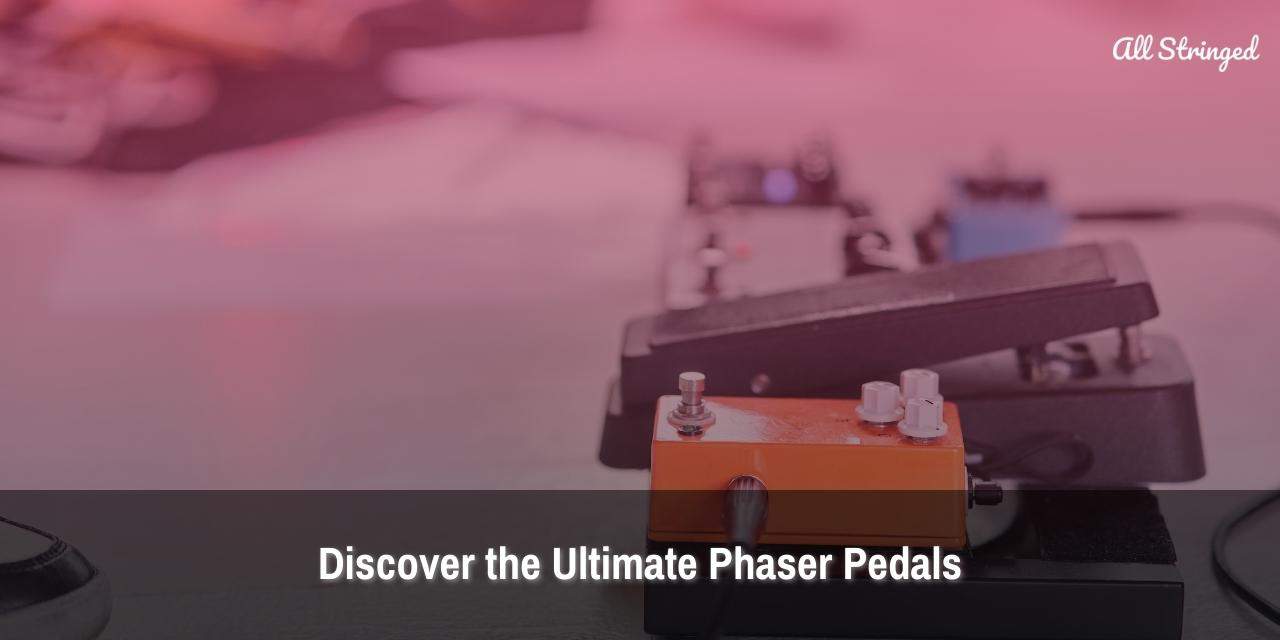Get ready to embark on a sonic journey like no other as we delve into the captivating world of phaser pedals. Whether you’re a seasoned guitarist or just starting out, these mesmerizing effects are sure to take your playing to new heights. From the subtle, swirling tones of vintage phasers to the bold and futuristic sounds of modern variations, the possibilities are endless. So, strap in and prepare to be amazed as we uncover the secrets behind the ultimate phaser pedal that will leave you craving for more.
What you need to know about phaser pedals:
- Phaser pedals come in various types, including analog, digital, and multi-mode options.
- Common features of phaser pedals include adjustable speed, depth, and feedback controls.
- When choosing a phaser pedal, consider factors such as your playing style, budget, and desired sound.
- To use a phaser pedal effectively, experiment with different settings and incorporate it subtly into your playing.
- Proper maintenance and care, such as cleaning the pedal and checking for loose connections, can prolong its lifespan.
Types of Phaser Pedals
Phaser pedals are a popular choice among guitarists looking to add a unique and dynamic effect to their sound. These pedals create a swirling, sweeping sound that adds movement and depth to your guitar tone. With a wide range of options available on the market, it can be overwhelming to choose the right phaser pedal for your needs. In this section, we will explore the different types of phaser pedals and their characteristics.
>>> Click here to read our review about the Top 5 Best Phaser Pedals <<<
- Analog Phaser Pedals:
Analog phaser pedals are known for their warm and organic sound. They use analog circuitry to create the phase-shifting effect, resulting in a rich and vintage tone. These pedals often have a simple control layout, typically consisting of speed, depth, and feedback knobs. Some popular analog phaser pedals include the MXR Phase 90 and the Electro-Harmonix Small Stone. - Digital Phaser Pedals:
Digital phaser pedals use digital signal processing to create the phase-shifting effect. These pedals offer a wide range of tonal possibilities and often come with additional features such as multiple stages, tap tempo, and preset options. Digital phasers can replicate the sound of classic analog pedals or provide more experimental and futuristic tones. The Boss PH-3 Phase Shifter and the Strymon Mobius are examples of versatile digital phaser pedals. - Multi-Modulation Pedals:
Multi-modulation pedals combine different modulation effects, including phaser, chorus, and flanger, into a single unit. These pedals offer a variety of sounds and allow guitarists to experiment with different modulation effects without needing multiple pedals. They often come with extensive control options and presets for easy customization. The Line 6 M5 Stompbox Modeler and the Eventide ModFactor are popular multi-modulation pedals that include phaser effects. - Vintage Phaser Pedals:
Vintage phaser pedals aim to recreate the sound and characteristics of the classic phasers from the 1960s and 1970s. These pedals often feature analog circuitry and simple controls, capturing the essence of the original designs. Vintage phasers are sought after by guitarists looking to achieve a retro sound or recreate specific iconic tones. The MXR Phase 45 and the Electro-Harmonix Small Stone Nano are examples of vintage-inspired phaser pedals. - Boutique Phaser Pedals:
Boutique phaser pedals are handcrafted, often in limited quantities, by small independent manufacturers. These pedals are known for their high-quality components, attention to detail, and unique designs. Boutique phasers offer a range of tonal options, from vintage recreations to innovative and experimental sounds. They are favored by guitarists who value craftsmanship and want a pedal that stands out both visually and sonically. Examples of boutique phaser pedals include the Chase Bliss Audio Wombtone and the JHS Unicorn.
In conclusion, choosing the right phaser pedal depends on your personal preferences and the sound you want to achieve. Whether you prefer the warmth of analog, the versatility of digital, or the charm of vintage-inspired designs, there is a phaser pedal out there to suit your needs. Consider trying out different types and brands to find the perfect phaser pedal that will add a captivating and dynamic element to your guitar playing.
>>> Click here to read more about Guitar Pedals <<<
Common Features of Phaser Pedals
Phaser pedals are a popular type of guitar effect pedal that can add a unique and swirling sound to your guitar tone. They are commonly used in various genres of music, including rock, funk, and psychedelic. If you’re considering adding a phaser pedal to your guitar rig, it’s important to understand the common features that these pedals offer. In this section, we will explore the key features of phaser pedals to help you make an informed decision.

Speed Control
One of the primary features of a phaser pedal is the speed control. This knob allows you to adjust the rate at which the phasing effect cycles through the audio signal. By increasing the speed, you can create a faster and more pronounced swirling effect, while slowing it down can produce a subtle and gentle phasing sound. The speed control is typically labeled as “Rate” or “Speed” on most phaser pedals.
Depth Control
The depth control on a phaser pedal determines the intensity or depth of the effect. It controls the range of the sweep, allowing you to choose between a subtle, almost imperceptible phasing effect or a more pronounced and noticeable sound. By adjusting the depth control, you can customize the level of phasing to suit your preferences and the musical context.
Feedback Control
Some phaser pedals also feature a feedback control, which alters the resonance or feedback of the phasing effect. This control can add a unique character to the sound by emphasizing certain frequencies within the phaser sweep. Experimenting with the feedback control can help you achieve different tonal variations and textures.
Number of Stages
Phaser pedals can have different numbers of stages, which refers to the number of notches or peaks in the phasing sweep. The more stages a phaser pedal has, the more complex and pronounced the effect will be. Pedals with fewer stages tend to produce a more subtle and smooth phasing sound, while those with more stages can create a more intense and dramatic effect. The number of stages is often indicated on the pedal and can range from two to twelve or more.
Controls and Switches
Apart from the common features mentioned above, phaser pedals may also include additional controls and switches to further shape the sound. These can include:
- Resonance Control: This control adjusts the emphasis on certain frequencies within the phaser sweep, allowing you to create a more focused or broader sound.
- Mix Control: The mix control determines the balance between the dry (unaffected) and wet (phased) signal. This allows you to blend the phaser effect with your original guitar tone.
- Toggle Switches: Some phaser pedals offer toggle switches to select different modes or voicings, providing additional tonal options and versatility.
In conclusion, phaser pedals offer a range of features that allow guitarists to create unique and captivating sounds. By understanding the common features such as speed control, depth control, feedback control, and the number of stages, you can choose a phaser pedal that suits your musical style and preferences. Experimenting with different settings and controls will help you unlock the full potential of your phaser pedal and add an exciting dimension to your guitar playing.
Choosing the Right Phaser Pedal for Your Needs
Phaser pedals are a popular choice among guitarists looking to add a unique and swirling effect to their sound. With so many options available on the market, it can be overwhelming to choose the right phaser pedal for your needs. In this section, we will explore some key factors to consider when selecting a phaser pedal and provide you with a guide to help you make an informed decision.
Types of Phaser Pedals
Phaser pedals come in various types, each offering a distinct sound and functionality. Understanding the different types can help you narrow down your options and find the perfect phaser pedal for your musical style. Here are some common types of phaser pedals:
- Analog Phaser: Analog phaser pedals use analog circuitry to create a warm and organic sound. They are known for their smooth and subtle modulation, making them a popular choice for vintage and classic rock tones.
- Digital Phaser: Digital phaser pedals utilize digital technology to recreate a wide range of phaser sounds. They often offer more versatility and control options, allowing you to experiment with different modulation patterns and intensities.
- Multi-Stage Phaser: Multi-stage phasers feature multiple stages of phase shifting, resulting in a more complex and dynamic sound. These pedals are ideal for guitarists who want to explore more intricate and psychedelic phaser effects.
- Envelope Phaser: Envelope phasers respond to the dynamics of your playing, creating a sweeping effect that is triggered by your picking attack. These pedals can add a touch of expressiveness to your playing and are particularly popular in funk and rhythm guitar styles.

Key Features to Consider
When choosing a phaser pedal, there are several key features to consider to ensure it meets your specific needs. Here are some important factors to keep in mind:
- Controls: Look for a phaser pedal that offers intuitive and easy-to-use controls. Common controls include rate (modulation speed), depth (intensity of the effect), and feedback (number of phase stages). Having control over these parameters allows you to dial in the perfect phaser sound.
- Versatility: Consider the versatility of the phaser pedal. Does it offer a wide range of modulation sounds? Can it produce subtle, gentle sweeps as well as more intense and pronounced effects? A versatile phaser pedal will allow you to explore different sonic possibilities.
- Build Quality: Pay attention to the build quality of the pedal. A sturdy and durable construction ensures that the pedal can withstand the rigors of live performances and regular use. Look for pedals made from high-quality materials and reputable brands.
- True Bypass: True bypass is a feature that allows your guitar’s signal to pass through the pedal without any alteration when the effect is turned off. This ensures that your tone remains unaffected when the phaser is not in use.
When it comes to choosing the right phaser pedal for your needs, consider the type of phaser, key features, and your budget. Take the time to research and listen to demos to find a pedal that matches your desired sound. By considering these factors, you’ll be well on your way to finding the perfect phaser pedal to add depth and dimension to your guitar playing.
Tips for Using a Phaser Pedal Effectively
A phaser pedal is a popular guitar effect that adds a swirling, swooshing sound to your playing. It can create a sense of movement and depth, making your guitar tone more interesting and dynamic. To get the most out of your phaser pedal, here are some tips to help you use it effectively.
Experiment with Different Settings
One of the great things about a phaser pedal is its versatility. It offers a range of controls that allow you to shape the effect to your liking. Start by experimenting with the speed and depth knobs. The speed control adjusts how fast the phaser sweeps through the frequencies, while the depth control determines the intensity of the effect. Play around with these settings to find the sweet spot that suits your playing style and the song you’re working on.
Adjust the Feedback and Resonance
Many phaser pedals also feature feedback and resonance controls. The feedback control adjusts the amount of effect that is fed back into the pedal, while the resonance control emphasizes certain frequencies in the effect. These controls can significantly alter the character of the phaser, so don’t be afraid to experiment with them. Increasing the feedback can create a more pronounced and intense effect, while adjusting the resonance can give your tone a sharper or smoother edge.
Utilize Different Phaser Modes
Some phaser pedals offer multiple modes, such as 2-stage, 4-stage, or 8-stage phasing. Each mode produces a different number of phase stages, resulting in varying tonal characteristics. Experiment with different modes to find the one that suits your musical style and the desired effect. For example, the 2-stage mode may provide a subtle and smooth phasing effect, while the 8-stage mode can deliver a more pronounced and intense swirling sound.
Combine with Other Effects
To enhance your guitar tone even further, consider combining the phaser pedal with other effects. For instance, using a phaser in conjunction with a delay pedal can create a mesmerizing, atmospheric sound. Experiment with different pedal combinations to discover unique and captivating tones. Remember to place the phaser pedal before or after other effects in your signal chain to achieve the desired sonic result.
Tips for Live Performance
When using a phaser pedal in a live performance, it’s essential to consider a few factors to ensure a seamless experience. Here are some tips to help you make the most of your phaser pedal on stage:
- Set the phaser pedal before the gig: Spend some time before the show to dial in your preferred settings and make sure the pedal is working correctly.
- Use an isolated power supply: To avoid unwanted noise and interference, use a dedicated power supply for your phaser pedal. This will help maintain a clean and reliable signal.
- Engage the effect selectively: While the phaser pedal can add depth and interest to your playing, it’s essential to use it judiciously. Engage the effect during specific sections of a song or for particular guitar parts to create impact and variation.
- Practice with the band: If you’re playing with a band, practice using the phaser pedal in a live setting. This will help you find the right moments to incorporate the effect and ensure it blends well with the overall sound.
In conclusion, a phaser pedal can add a captivating and dynamic element to your guitar playing. By experimenting with different settings, utilizing various phaser modes, and combining it with other effects, you can create unique and mesmerizing tones. Remember to consider the tips for live performance to ensure a seamless experience on stage. With practice and exploration, you’ll discover the full potential of your phaser pedal and unlock new sonic possibilities.

Maintenance and Care for Your Phaser Pedal
Phaser pedals are a popular choice among guitarists for adding depth and dimension to their sound. These pedals create a swirling, sweeping effect that can take your guitar tone to a whole new level. To ensure that your phaser pedal continues to perform at its best, it’s important to properly maintain and care for it. In this section, we will discuss some essential tips and guidelines for keeping your phaser pedal in top shape.
Cleaning and Dusting
Regular cleaning and dusting are crucial for maintaining the longevity of your phaser pedal. Over time, dust and dirt can accumulate on the surface and inside the pedal, affecting its performance. Here are some steps you can follow to clean your phaser pedal effectively:
- Use a soft, dry cloth to wipe the exterior of the pedal gently. Avoid using abrasive materials or harsh chemicals as they may damage the finish.
- For hard-to-reach areas, such as knobs and switches, use a small brush or a cotton swab dipped in isopropyl alcohol. Be cautious not to apply excessive liquid, as it may seep into the internal components.
- If your phaser pedal has a footswitch, ensure that it is free from dirt and debris. Use compressed air or a small brush to clean the footswitch mechanism.
Power Supply
Proper power supply is essential for the optimal performance of your phaser pedal. Here are a few tips to keep in mind:
- Always use the correct power adapter that is specifically designed for your phaser pedal. Using the wrong adapter can damage the pedal or compromise its performance.
- Avoid using adapters with higher voltage ratings than recommended. Excessive voltage can cause internal components to overheat and potentially fail.
- If possible, use a surge protector or a power conditioner to protect your phaser pedal from power surges or fluctuations.
Storage and Transportation
When not in use or during transportation, it’s important to store and handle your phaser pedal with care. Here are some guidelines to follow:
- Keep your phaser pedal in a dry and cool environment, away from direct sunlight or extreme temperatures. Excessive heat or humidity can damage the internal circuitry.
- If you are transporting your pedal, consider using a padded gig bag or a hard case to protect it from bumps and impacts.
- Avoid placing heavy objects on top of your phaser pedal, as it can cause damage to the enclosure or internal components.
Troubleshooting
Despite proper maintenance, issues may arise with your phaser pedal. Here are some common problems and possible solutions:
- No sound or weak output: Check the cables and connections for any loose or faulty connections. Ensure that the pedal is receiving power and that the battery (if applicable) is charged or replaced.
- Excessive noise or distortion: Clean the input and output jacks using a contact cleaner. If the issue persists, it may indicate a problem with the internal components, and professional repair might be necessary.
- Erratic or inconsistent effect: Check the battery (if applicable) and power supply for sufficient voltage. If the problem persists, it could be due to a faulty switch or potentiometer, which may require professional repair or replacement.
Regular maintenance and care are essential for preserving the performance and lifespan of your phaser pedal. By following these guidelines, you can ensure that your pedal continues to deliver the mesmerizing swirling effect that guitarists love.
Conclusion
In conclusion, the world of guitar effects is vast and exciting, and the phaser pedal is a must-have for any guitarist looking to add a mesmerizing touch to their sound. With its ability to create swirling sonic waves and captivating tones, the phaser pedal opens up a whole new realm of possibilities for your music.
Throughout this article, we explored the different types of phaser pedals available, from classic analog to modern digital options. We also discussed the common features to look for when choosing the right phaser pedal for your needs, ensuring that you find the perfect match for your playing style.
Additionally, we provided some valuable tips for using a phaser pedal effectively, helping you unlock its full potential and create unique sounds that will captivate your audience. And let’s not forget about the importance of maintenance and care for your phaser pedal, ensuring its longevity and optimal performance.
So, whether you’re a seasoned guitarist or just starting your musical journey, don’t miss out on the incredible sonic possibilities that a phaser pedal can offer. Experiment, explore, and let your creativity soar as you unleash mesmerizing guitar effects with the ultimate phaser pedal. Get ready to take your music to new heights and leave your listeners in awe.
Frequently Asked Questions for Phaser Pedal
What is a phaser pedal and how does it work?
A phaser pedal is an effects pedal used in music to create a swirling, sweeping sound. It works by splitting the audio signal into two paths, altering the phase of one path, and then combining them back together. This creates a shifting phase effect that gives the sound its characteristic “whooshing” quality.
What are the different controls on a phaser pedal and what do they do?
Phaser pedals typically have controls such as rate, depth, feedback, and mix. The rate control adjusts the speed at which the phase effect cycles. The depth control determines the intensity or depth of the effect. The feedback control adjusts the amount of the effect that is fed back into the pedal, creating resonance. The mix control allows you to blend the phaser effect with the original signal.
Can a phaser pedal be used with other guitar effects pedals?
Yes, a phaser pedal can be used in combination with other guitar effects pedals. It can be placed before or after other pedals in the signal chain, depending on the desired sound. Experimenting with different pedal combinations can lead to unique and interesting tones.



